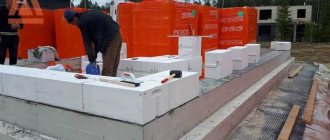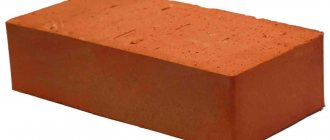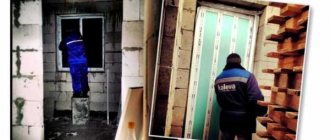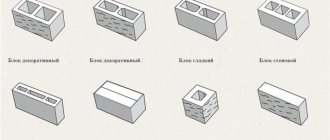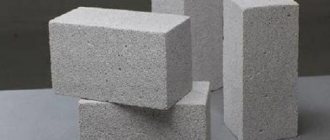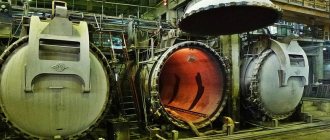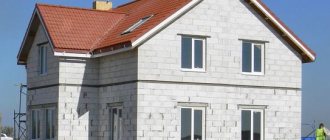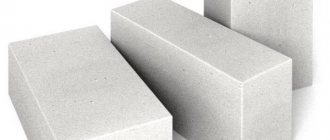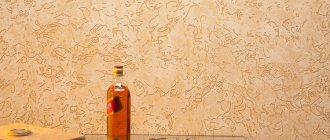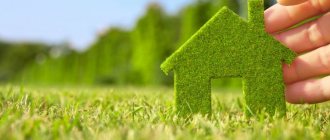Today we have to study aerated concrete - technology and composition
In recent years, aerated concrete has noticeably displaced traditional materials (brick, natural stone) in the building materials market. Our topic today is production technology and composition of aerated concrete.
We will find out what raw materials are used in the manufacture of the material, what are the requirements for it and in what order the technological operations are performed. But first, a few words about the advantages of aerated concrete.
Why aerated concrete
Here is a short list of its advantages against the background of natural stone and brick:
- Excellent thermal insulation qualities . The thermal conductivity of aerated concrete blocks is three times lower than that of brickwork;
- Vapor and air permeability . This means that a house made of aerated concrete will never be stuffy or damp;
- Simple processing . In particular, you can cut a block with a density up to D600 using a regular garden hacksaw;
Aerated concrete block can be easily cut with a regular hacksaw
- Large block size , which speeds up the construction process many times over;
- Ideal geometry (in the case of autoclaved aerated concrete) and precisely maintained block dimensions. These features make it possible to reduce the thickness of masonry joints to a minimum, and, therefore, get rid of cold bridges - areas of masonry with high thermal conductivity;
Please note: aerated concrete is not placed on a cement-sand mortar, but on cement glue with a minimum filler fraction size. The glue allows you to reduce the thickness of the seam to 2-3 mm.
Please note the minimum thickness of masonry joints
- Competitive price (from 3,000 rubles per cubic meter), approximately corresponding to the cost of aerated concrete’s main competitor - hollow ceramic bricks.
A caveat: aerated concrete blocks have low bending strength. Hence the high requirements for the rigidity of the foundation: when it deforms, the walls are guaranteed to crack. In addition, one-story buildings made of aerated concrete are equipped with reinforced belts, and houses with two or more floors are equipped with reinforced frames.
Uneven shrinkage of the house often leads to cracks
Fire safety
During a fire, a serious threat to people is the release of substances hazardous to health from building materials under the influence of fire. If the material does not release such substances, people have enough time to evacuate the building. Therefore, before purchasing wall material, ask sellers for fire safety test results, and not only the wall material, but the entire wall structure.
Please note: when answering the question about fire safety, many manufacturers show fire resistance test results. Of course, fire resistance is very important: the longer a structure retains its load-bearing capacity under the influence of fire, the greater the chance of people being saved during a fire. But such tests do not provide information about the release of substances that threaten human health during a fire. Such information is available in tests, according to the results of which the structure is assigned to a particular fire hazard class. So require a certificate indicating the fire hazard class.
Aerated concrete is a non-flammable material. Based on the results of independent tests, the load-bearing structure made of YTONG aerated concrete with thin-seam masonry mortar corresponds to fire hazard class K0(45)**. That is, it is non-flammable with a heat exposure time of 45 minutes. And can act as a fire barrier. This class is assigned only to those structures that do not support combustion and do not emit harmful substances when directly exposed to fire.
In central Russia, walls made of aerated concrete blocks with a density of D400 and a thickness of 375 mm, as a rule, do not need to be insulated; they meet modern requirements for thermal protection. However, if you still want to further insulate them, do not forget that polymer thermal insulation (expanded polystyrene - regular or extruded) belongs to the groups of normally or highly flammable materials. This means that during a fire they pose a danger to human health. As for mineral wool insulation, they are non-flammable.
Let us add that the fire resistance of aerated concrete walls is the highest among all types of stone or monolithic structures. This is explained by the fact that the material has low thermal conductivity, and the thermal wave front moves slowly along the masonry of aerated concrete blocks.
Components and Requirements
So, aerated concrete: composition and requirements for components.
Water
Quantity: from 250 to 300 liters per cubic meter of finished material.
Requirements: water must comply with GOST 23732-79, which regulates its quality for the preparation of concrete and cement mortars. Drinking water according to GOST R 51232-98 can also be used for mixing (simply put, water can be taken from the cold water supply system of any building).
Tap water can be safely poured into a concrete mixer
If the source of water is a well or well, it is preferable to select it from surface aquifers: to prepare aerated concrete, low or medium hardness with minimal salinity is required.
An important point: the mixing water must be heated to a temperature of 40-60°C. Its heating will ensure rapid hydration of cement and, accordingly, rapid maturation of the blocks with an increase in their final strength. The heating costs will more than pay off due to increased line productivity.
Cement
As a binder, non-autoclaved aerated concrete blocks include a material familiar to any builder - Portland cement:
- Quantity: from 260 to 320 kg per cubic meter of finished product, depending on the brand of Portland cement and the requirements for the final strength of the blocks.
- Quality: Portland cement must meet the requirements of GOST 10178-85. Cement grades suitable for the production of naturally hardening aerated concrete blocks are M 400 D 20 and M 500 D 20.
Portland cement M 400 D 20
Important: cement must contain a sufficient amount of soluble alkalis. Their deficiency is compensated by the addition of caustic soda (caustic soda NaOH) or lime binder (slaked lime). The addition of lime, in addition to gas formation, provides the characteristic white or light gray color of the blocks.
The addition of lime binder gives the blocks a characteristic light gray or white color
Filler
Quantity: from 250 to 350 kg per cubic meter. The exact mass of the filler depends on the requirements for the strength of aerated concrete and its final density: the higher the density, the greater the compressive load the block can withstand.
Type: the composition of an aerated concrete block may include river, sea or quarry sand, ash from boiler houses and thermal power plants, dolomite flour, ground limestone and other mineral fillers.
Requirements:
- Minimum fraction size. The finer the filler, the smaller the pores will be and the smoother the surface of the block will become;
Sand for the production of aerated concrete: fine, clean, free of impurities
- Absence of foreign inclusions (branches, stones, organic debris);
- Minimum amount of silt and clay impurities.
Modifiers
Additives that accelerate the maturation of concrete play this role:
| Image | Description |
Construction gypsum | Gypsum alabaster |
Technical calcium chloride | Calcium chloride |
Sodium liquid glass | Liquid glass (sodium or potassium) |
Quantity: no more than 3 kg per cubic meter.
Gas-forming additive
Aluminum powder is responsible for foaming concrete. The reaction between aluminum and water in the presence of an alkali has the form 2AL + 6 H2O = 2AL(OH)3 + 3H2. It is the free hydrogen released when hydroxyl groups attach to aluminum atoms that creates closed pores in the concrete mass.
Quantity: 500-700 grams per cubic meter. Requirements: aluminum powder PAP-1 or PAP-2 is used.
PAP-1 powder in industrial packaging
Curious: fine powder generates dust when mixed, so it is often replaced with an aqueous suspension.
Mold release agent
Lubricant helps remove the block from the mold without disturbing its geometry and leaving the mold perfectly clean. Quantity: up to 0.5 kg per cubic meter of finished products.
Compound:
| Image | Description |
Lubricant for molds and formworks intended for the manufacture of concrete products | Specialized emulsions for mold lubrication |
Inexpensive vegetable oil can be used as a lubricant. | Waste from the production of vegetable oils, inexpensive vegetable oils (rapeseed, flaxseed, etc.) |
Used motor oil | Used motor and transmission oils |
Attention: used oil from diesel crankcases should not be used to lubricate molds. The instructions are due to their high soot content.
Technology
Industrial conditions
Full production cycle of autoclaved aerated concrete
How aerated concrete is produced in large-scale production conditions:
- The components (Portland cement, sand or other filler, lime, modifiers and blowing agents) are loaded into separate bins;
- The coarse filler is ground into mineral flour;
- The components are dosed depending on the requirements for the density of the finished blocks and mixed with water in a concrete mixer;
- The mixture is poured into a large-volume mold, where gas formation gives it a porous structure. The form is placed on a vibration stand. Vibration helps to achieve uniform, void-free filling;
- In the pre-ripening chamber (the so-called hot tunnel), in 3-4 hours at a temperature of about 40°C, the mixture gains strength sufficient for stripping (removal from the mold);
The aerated concrete mass is transported to the place of cutting into blocks
- At the cutting line, the array is transformed into individual blocks. High-strength metal strings are used for cutting. Since cutting is performed in three planes, the array is turned during the cutting process;
Please note: at this stage, tongue-and-groove locks can be formed on the blocks, making adhesion within one row of masonry and between rows more reliable, as well as hand grips, making it easier to transport the blocks.
- Formed, but not yet strengthened, blocks enter the autoclave. Their maturation takes place under excess pressure (about 12 kgf/cm2), high humidity and temperature (+180°C). Autoclaving ensures complete absence of shrinkage and cracks;
Loading cut blocks into the autoclave
- The blocks, which have passed quality control and are packed in polyethylene, are loaded onto pallets and sent to the finished product warehouse.
Handicraft production
If you are going to produce aerated concrete blocks with your own hands, the composition and proportions of the components will be approximately as follows:
- Sand - 180 kg;
- Cement - 100 kg;
- Water - 60 liters;
- Caustic soda - 600 g;
- Aluminum powder - 230 g;
Useful: add one and a half kilograms of sodium sulfate (known, by the way, as a strong laxative) to the mixture. It will dramatically accelerate the maturation of aerated concrete.
And here is a step-by-step description of the technology for handicraft block making:
- We pour water heated to 60 degrees into the concrete mixer (from the hot water supply or, which is much better, from the boiler);
- We fill in 2/3 of the total amount of sand and half of the cement;
- Stir for 10 minutes;
- Add the remaining sand and cement with continuous stirring;
- Add caustic soda, sodium sulfate (optional) and aluminum powder diluted with water into the mixture;
Caustic soda creates an alkaline environment and provides gas formation
Attention: PAP powder particles are coated with paraffin for reasons of safe storage. To wash it off, dilute the powder with warm water and regular washing powder. Powder is added at the rate of 3-5% of the amount of powder. If there is more of it, gas formation will decrease.
- Stir for another minute, then pour the mixture into pre-greased molds and cover them with plastic wrap for 10 minutes;
The photo shows molds for the production of aerated concrete blocks
- After the mixture rises to its maximum and settles, cut off everything that protrudes beyond the mold;
- A day later, we unload the set blocks from the molds, store them and wait for them to gain full strength within 2-4 weeks.
At room temperature and in the absence of ripening-accelerating additives, aerated concrete gains full strength within a month
Useful: the requirements for the room where the blocks are formed and dried are a temperature of +5 - +25 degrees and no drafts.
Hermès International SA
., or simply
Hermès
, is a French haute couture house founded
in 1837,
today specializing in leather goods, accessories, perfumes, luxury goods and ready-to-wear.
The company's logo, since 1950
, has been
a horse-drawn carriage
.
Throughout the company's history, designers have been
: Lola Prusak, Jacques Delay, Catherine de Caroli, Nicole de Vaisian, Eric Berger, Claude Brouillet, Tan Giudicelli, Marc Odibe, Mariot Chane, Martin Margiela, Jean-Paul Gaultier, Véronique Nichanyan (current menswear designer), Christophe Lemaire.
If you look at the company's logo, you will notice the silhouette of a horse harness. There seems to be no connection between the fashion house, which supplies society’s elite with the most exquisite and high-quality accessories, and horses. But it is to horses, or rather, to the skill of tanners who make harnesses for horse-drawn carriages, that the fashion house owes its prosperity. Its founder was a very talented and hardworking emigrant from Germany, Thierry Herme
, who, in a country foreign to him, was able to turn his small workshop with a few auxiliary workers into a monopolistic company that took orders for the production of harnesses for the royal courts of not only Europe, but distant Japan and Russia.
The Protestant Hermes family, originally from Germany, settled in France in 1828. In 1837,
Thierry Hermès (1801–1878) founded the Hermès saddlery workshop
in the Grands Boulevards area of Paris
, where he catered exclusively to members of aristocratic circles.
He is engaged in the manufacture of the best examples of horse harnesses for carriages and bridles, which he successfully sells. In 1855, at the Paris exhibition Expositions Universelles, Thierry Hermès received a prize in his class, and in 1867, at the same exhibition, he received a first class medal. In 1880, Hermes' son, Charles-Émile Hermes (1835-1919), took over his father's business and moved the store to 24 rue Faubourg de Saint-Honoré,
where it is still located today.
The new manager expanded the range of saddlery products, adding saddle equipment, and began selling products not only to the aristocracy, but also to everyone. The sons of Charles-Emile Hermes, Adolphe and Emile-Maurice, also participate in the family business; the company serves the elite of Europe, North Africa, Russia, Asia, North and South America. In 1900,
the company developed the Haut à Courroies bag, designed specifically for riders, to carry a saddle.
The first owner of a purely ladies' item from Hermes was the wife of Emile Maurice, who could not find a practical handbag in haberdashery stores in Paris. The first Hermes handbag was made for her - with a zipper and a seam. The first handbag was black, but today the Hermes fashion house offers its customers a rich range of colors, which includes almost 100 shades. Along with calf leather, it became possible to order a handbag made of crocodile, ostrich and exotic animals - lizards. Despite the fact that the range of products has expanded significantly, the unsurpassed quality of handcraft remains unchanged.
It was silk that brought worldwide fame to the Hermes house: at the end of 1920, the fashion house came under the control of Robert Dumas,
which
in 1928
launched the famous line of silk scarves for which Hermes became famous throughout the world, as well as ties, a line of perfumes and beach towels.
The classic silk bob
is a 90 x 90 centimeter square made from 65 grams of the finest silk, obtained from 250 cocoons, with a unique, invariably hand-printed design. The drawings show races and jumps, zodiac signs and images of Matisse, ornaments in the form of keys and wild animals. A Hermes scarf has become the most democratic way to join the luxury brand. Among the legendary fans of the bob are the Queen of England, Grace Kelly (she tied her broken arm), Audrey Hepburn and Jacqueline Kennedy. It was the Hermès scarf that Sharon Stone used to tie up her victims in Basic Instinct.
The company's current fashion designers adhere to established classical traditions in their work, which is why Hermes has been a trendsetter not only in fashion, but also in style for decades. Things from Hermes have long become a sign of wealth and respectability.
Six years ago, the head of the trading house, Jean-Louis, invited a new designer, the young Belgian Martin Margiela, to Hermes. With his arrival, the collection models of the Hermès house have changed significantly. New modern trends, deviating from conservative principles, were to the taste of Hermès customers - allowing the company to take one of the first places in the ready-to-wear market. The current creative director of Hermès is Jean-Paul Gaultier.
.
Information sources:
- Fashion house Hermes.
- Hermes. Wikipedia.
- Sign of the breed. Women's magazine (history of the Hermes brand).
